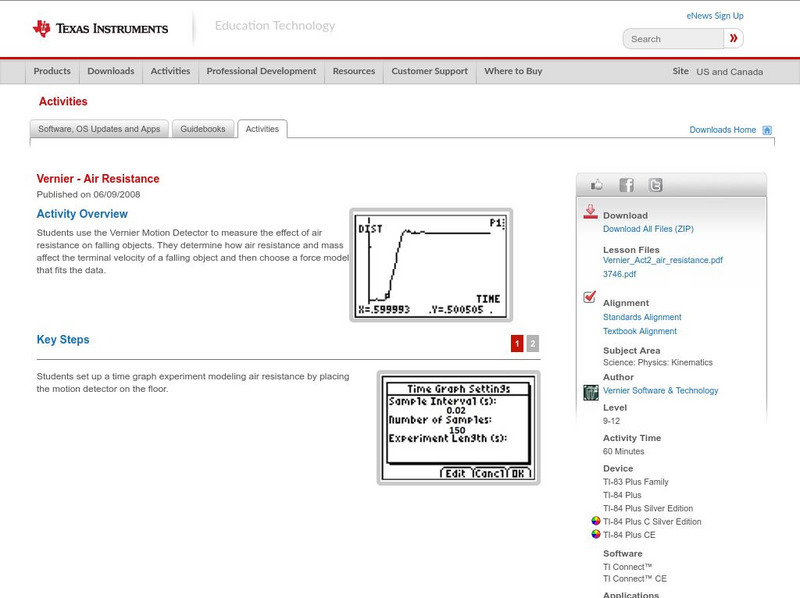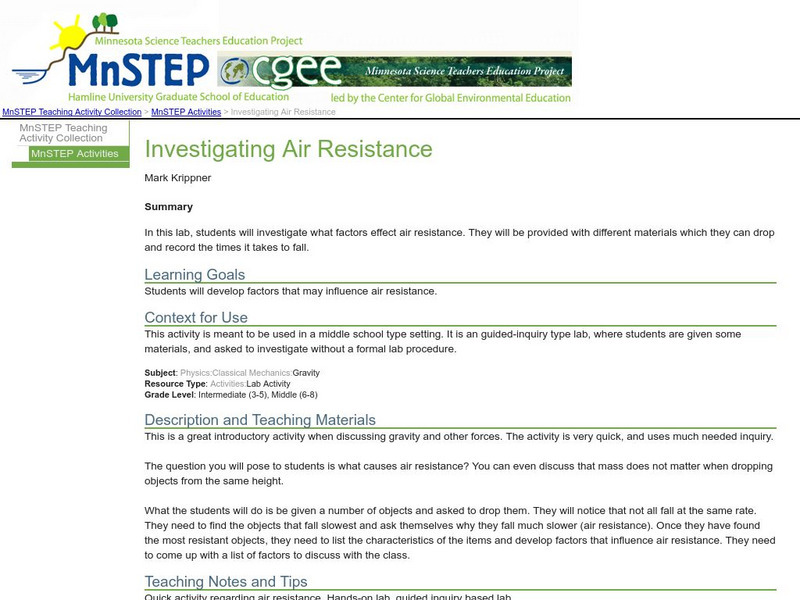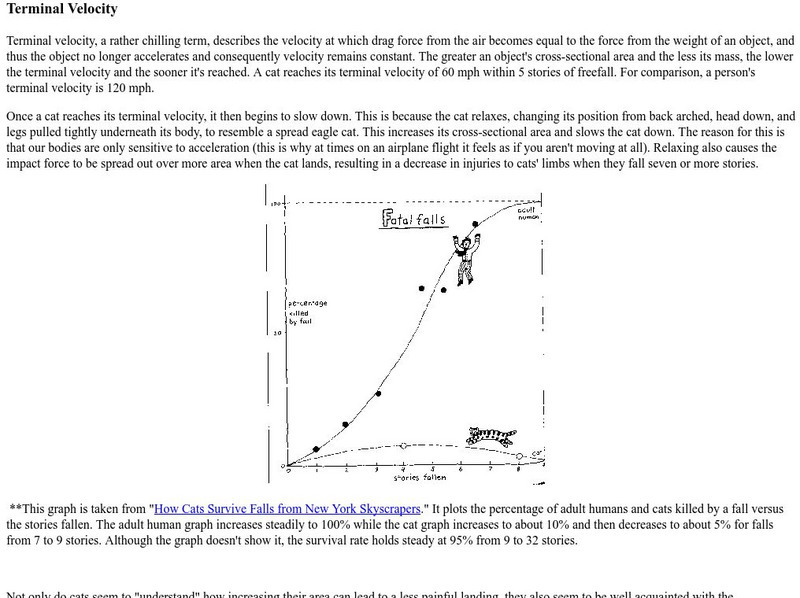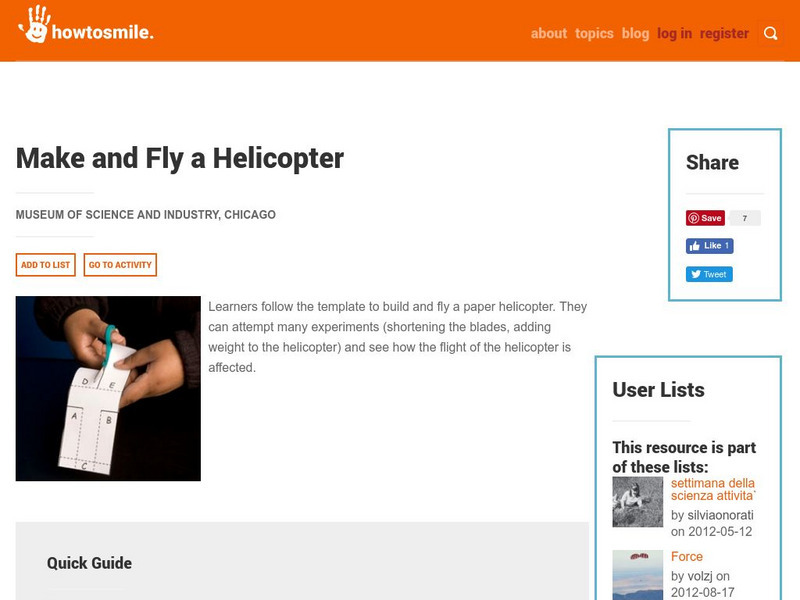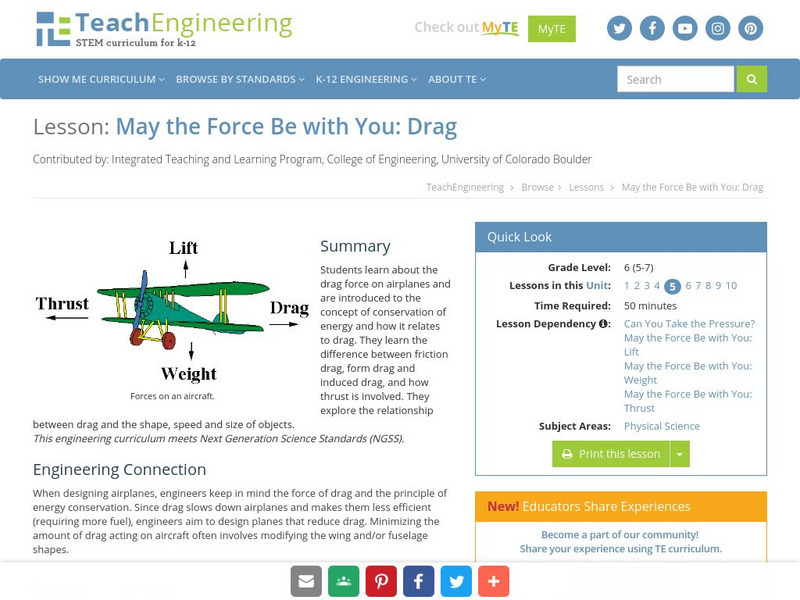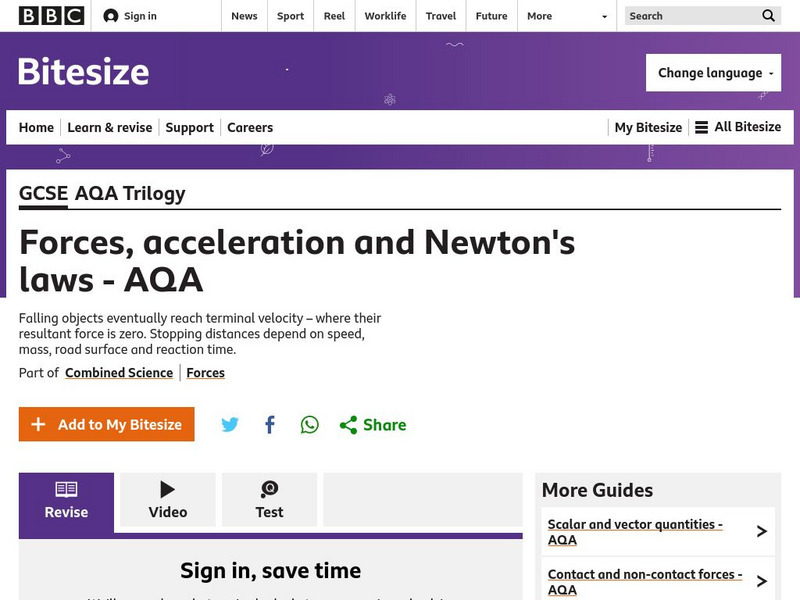Georgia State University
Georgia State University: Hyper Physics: Air Friction
Physics lab definition of air fiction. Part of a hypertext physics course on sound.
Texas Instruments
Texas Instruments: Air Resistance
Students use the Motion Detector to measure the effect of air resistance on falling objects. They determine how air resistance and mass affect the terminal velocity of a falling object and then choose a force model that fits the data.
Science Education Resource Center at Carleton College
Serc: Calculating Air Resistance Using the Monte Carlo Method
Learners will use Vernier motion detector and Logger Pro software to first discover if air resistance of an industrial size coffee filter is a vtm or vt2m relationship (vt = terminal velocity). Once this relationship is found it will be...
Science Education Resource Center at Carleton College
Serc: Investigating Air Resistance
In this lab, students will investigate what factors affect air resistance while introducing gravity and other forces.
Project Britain
Primary Homework Help: Forces Quiz
First, read some fast facts about forces, then take a ten-question, multiple-choice quiz. Check to see if your answers are correct after each question.
Other
University of Alaska: Terminal Velocity
University of Alaska physics professor site explaining the concept of terminal velocity. Uses the terminal velocities of humans and cats for comparison. Site contains an interesting graph of the percent fatalities versus stories fallen.
NASA
Nasa: Beginner's Guide to Aeronautics
A website that catalogs information and activities for how airplanes work. The concept of aerodynamics is explained in full detail.
Concord Consortium
The Concord Consortium: Molecular Workbench: Freefall 3 D
Change variables to see how an object reacts to freefall in a 3D environment.
E-learning for Kids
E Learning for Kids: Science: Pirates: What Are Some Forces Around Us?
Covers the meanings of force, friction, and gravity, and the differences between magnetic and elastic spring force, and between weight and mass. The effect of air resistance on an object's motion is also touched upon.
Exploratorium
Exploratorium: Science Snacks: Falling Feather
Recreate Galileo famous demonstration to show that a heavy and light weighted object fall at the same acceleration in a vacuum.
Other
National Science Digital Library: Smile: Make and Fly a Helicopter
Sourced by Chicago's Museum of Science and Industry, students and educators will engage in building a helicopter and making it fly. Adaptations of extra weight or shortening blades will alter flight abilities making for an exciting...
TeachEngineering
Teach Engineering: How Do Things Fall?
Students learn that it is incorrect to believe that heavier objects fall faster than lighter objects. By close observation of falling objects, they see that it is the amount of air resistance, not the weight of an object, which...
TeachEngineering
Teach Engineering: Design a Parachute
After a discussion about what a parachute is and how it works, students will create a parachute using different materials that they think will work best. The students will test their designs, which will be followed by a class discussion...
TeachEngineering
Teach Engineering: May the Force Be With You: Drag
This lesson plan explores the drag force on airplanes. The students will be introduced to the concept of conservation of energy and how it relates to drag. Students will explore the relationship between drag and the shape, speed and size...
TeachEngineering
Teach Engineering: Red Light, Green Light
Building upon their understanding of forces and Newton's laws of motion, students learn about the force of friction, specifically with respect to cars. They explore the friction between tires and the road to learn how it affects the...
CK-12 Foundation
Ck 12: Physical Science: Acceleration Due to Gravity
[Free Registration/Login may be required to access all resource tools.] Acceleration due to gravity and why falling objects with different masses accelerate at the same rate.
Teachers TryScience
Teachers Try Science: Gravity in Action
Here is a hands-on experiment that lets you discover how and why gravity works by making your own little parachutes.
Physics Classroom
The Physics Classroom: Free Fall and Air Resistance
This lesson in high school physics on Newton's Second Law of Motion provides a discussion of free fall and air resistance, and answers, "Why do objects which encounter air resistance ultimately reach a terminal velocity?" and "In...
Discovery Education
Discovery Education: Physical Science: Gravity Gets You Down
In this lesson, students make predictions about falling objects of different sizes and masses to learn about gravity and air resistance. Includes audio vocabulary list and extension activities.
Physics Classroom
The Physics Classroom: Newtons Laws: Rocket Sledder Interactive
Experience the effect of friction, air resistance, and applied force upon a sledder. The speed, acceleration, and force values are displayed as the sled moves. Learners can vary the mass of the sledder and the size of the parachute...
Physics Classroom
The Physics Classroom: Newtons Laws: Skydiving Interactive
Students explore the motion of an object falling under the influence of air resistance. Force arrows and values are shown as the object falls, and a speedometer displays the speed of the object. The mass of the falling object and the...
BBC
Bbc: Gcse Bitesize: Forces
Forces are responsible for all the interactions between particles and objects. They can be put into two categories: contact forces and non-contact forces. Forces can be added up as vectors.
BBC
Bbc: Gcse Bitesize: Forces, Acceleration and Newton's Laws Aqa
This lesson focuses on Newton's First Law: an object remains in the same state of motion unless a resultant force acts on it. If the resultant force on an object is zero, this means: a stationary object stays stationary; a moving object...
University of Wisconsin
The Why Files: Friction and Fly Balls
Try to find the sweet spot for hitting a baseball so that it travels the greatest horizontal distance.



